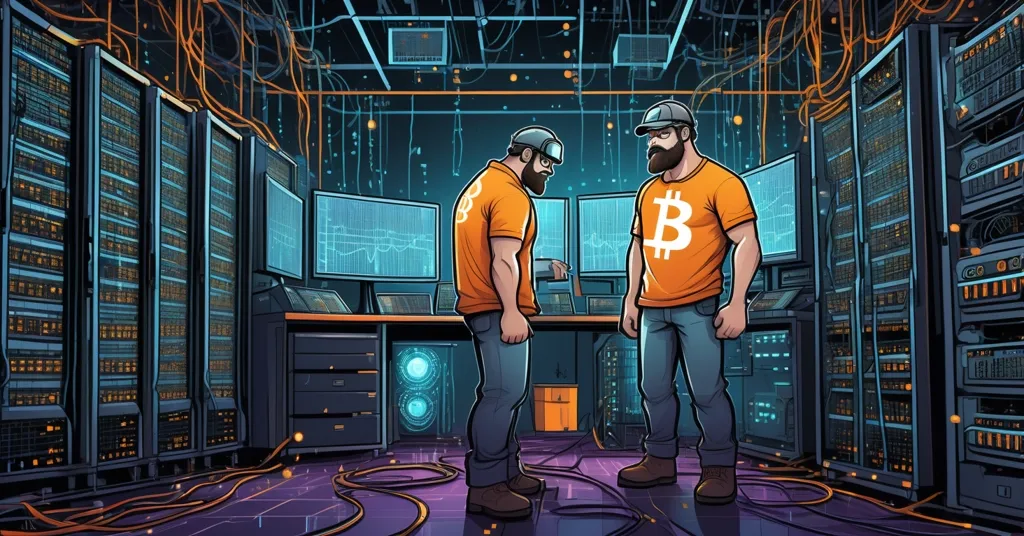Bitcoin Difficulty to Hit Record High: Miners Brace for 4.35% Surge

Bitcoin Difficulty Set for Another Jump: How High This Time?
Bitcoin’s mining arena is getting fiercer by the day as the network gears up for another Difficulty adjustment at midnight UTC. This critical self-regulating mechanism, designed to keep the blockchain humming at a steady pace, is poised to hit a jaw-dropping new peak, showcasing both the raw power of miners and the unyielding strength of Bitcoin’s design.
- Imminent Surge: Bitcoin Difficulty projected to climb 4.35%, reaching a record high of ~126.95 terahashes.
- Miner Speed: Blocks averaged 9.58 minutes over two weeks, outpacing the 10-minute target.
- Hashrate Boom: 7-day average Hashrate nears an all-time high, reflecting massive miner commitment.
What Is Bitcoin Difficulty and Why Does It Matter?
For the uninitiated, Bitcoin Difficulty is a core feature that dictates how tough it is for miners to solve the complex mathematical puzzles needed to add a block to the blockchain. Think of it as the network’s thermostat—set to maintain a consistent block production rate of roughly one every 10 minutes. This isn’t just some arbitrary rule; it’s a safeguard baked into Bitcoin’s code by its enigmatic creator, Satoshi Nakamoto, to prevent runaway inflation by controlling the flow of new Bitcoin through block subsidies (the primary reward miners earn, currently 3.125 BTC per block after the April 2024 halving). Without this, miners could flood the market with coins, devaluing the entire system. Every two weeks, or after 2,016 blocks, the network auto-adjusts Difficulty based on how fast or slow miners have been working. Too quick? It gets harder. Too slow? It eases up. It’s brutal, fair, and pure Bitcoin. Learn more about the Difficulty adjustment mechanism.
Right now, miners have been smashing the pace, clocking blocks at an average of 9.58 minutes over the last two weeks, according to data from CoinWarz. That’s faster than the target, signaling an influx of computational power—known as Hashrate—on the network. Hashrate measures the total muscle miners are throwing at Bitcoin, and when it spikes, blocks get solved quicker, prompting an upward Difficulty adjustment. The upcoming tweak is estimated at a 4.35% increase, pushing Difficulty to an unprecedented 126.95 terahashes—a number so massive it’s like millions of high-end laptops crunching numbers in unison. Blockchain.com data backs this up, showing the 7-day average Hashrate flirting with its own record high. Buckle up, miners—Bitcoin’s turning the heat up a notch.
Impact on Miners: Profitability Under Fire
So, are miners grinning or grimacing behind their rigs? Let’s break it down. A higher Difficulty means more computational grunt is required to snag the same block rewards, directly hitting profitability. Miners live off block subsidies and transaction fees, but with sky-high operational costs—think electricity bills and cutting-edge ASIC hardware—a 4.35% jump can be a gut punch, especially for smaller players. Post-2024 halving, where rewards were slashed from 6.25 to 3.125 BTC per block (a programmed event every four years to cap Bitcoin’s supply at 21 million), plenty of miners are already getting crushed, drowning in costs despite a 130% price surge this year, as noted by Crypto Briefing. In key mining hubs like Texas, where electricity can run $0.05-0.10 per kWh, every Difficulty spike translates to real-world expenses that can make or break operations. Check out some insights on how Difficulty impacts mining profitability.
Here’s the kicker: while network metrics scream bullish, Bitcoin’s price is playing hard to get. Sitting at around $105,800, it’s down over 2% in the past seven days per TradingView charts. This disconnect raises a spicy question—are miners stockpiling coins, betting on a rebound to $150K by next year, or dumping to cover costs? On-chain data from platforms like CryptoQuant often shows miner outflows spiking during Difficulty jumps, hinting at the latter. Either way, smaller outfits face Bitcoin mining challenges that could force them out, while big dogs with deep pockets just keep chugging along. It’s a grind, not the gold rush shillers hype it up to be. And speaking of shillers, beware of ‘cloud mining’ scams promising easy profits—mining’s a bloodbath, not a lottery ticket. Community perspectives on miner struggles with Difficulty increases highlight the harsh realities.
Network Security vs. Centralization Risks
On the flip side, this Difficulty surge to 126.95 terahashes is a roaring testament to Bitcoin’s security. A higher Hashrate means the network is damn near impossible to attack—think double-spending (trying to use the same Bitcoin twice) or a 51% takeover (controlling over half the network’s power to mess with transactions). It’s Satoshi’s vision in full force: a self-regulating fortress that gets tougher as more miners join the fight. Historically, Difficulty peaks—like after the 2021 China mining ban when Hashrate briefly tanked then soared—have often signaled miner confidence in Bitcoin’s long-term value, even amid short-term price dips. Explore more about Hashrate and its role in network security.
But not everyone’s cheering—Bitcoin’s energy appetite is drawing glares. Rising Hashrate and Difficulty often mean skyrocketing power use, with estimates from the Cambridge Bitcoin Electricity Consumption Index pegging Bitcoin’s draw as comparable to mid-sized nations. Sure, some miners are tapping renewables in places like Iceland or using stranded energy in remote grids, but critics aren’t exactly throwing confetti. Play devil’s advocate for a second: isn’t traditional banking’s carbon footprint just as ugly, with sprawling data centers and physical branches? Still, as Difficulty climbs, regulatory heat in energy-hungry regions could tighten the screws on miners.
Then there’s the elephant in the room: centralization. Higher Difficulty can push mining power into the hands of heavyweights like Foundry USA or AntPool, who dominate Hashrate with industrial-scale rigs. This clashes hard with Bitcoin’s decentralization ethos—the idea that no single player should call the shots. If smaller miners keep getting priced out, we risk a network where a few giants hold too much sway. Community fixes like supporting smaller pools or open-source mining software could help, but it’s a bitter irony: the very mechanism securing Bitcoin could, in extreme cases, undermine its democratic spirit. Dive into the risks of mining centralization for a deeper look.
Tech Innovation: Miners Fighting Back
Amid the doom and gloom, let’s not sleep on miner grit. Many are adapting to these Bitcoin Difficulty surges with cutting-edge tech. Newer ASIC models—specialized hardware built for mining—boast better efficiency, crunching more hashes per watt of power. Cooling tech, like immersion systems dunking rigs in dielectric fluid, is slashing energy waste. Some operations are even relocating to colder climates to cut cooling costs. This relentless drive to innovate is peak effective accelerationism—pushing boundaries to keep Bitcoin unstoppable, even if it’s a brutal arms race. Unlike flashy altcoin networks with centralized gimmicks, Bitcoin’s algorithm just works. It’s ruthless, but it’s ours.
Future Adjustments: Relief or More Pain?
Looking ahead, there’s a glimmer of hope—or maybe just a breather. While this adjustment ramps up Difficulty, CoinWarz data hints the next one, projected around mid-June 2025, could see a sharp 9.50% decrease to 114.92 terahashes, driven by current block times slowing to 11.05 minutes. What’s behind this? Could be seasonal energy cost spikes, regulatory clampdowns, or miners capitulating under pressure. If Hashrate stabilizes or dips, it might ease the squeeze on smaller players. But don’t pop the champagne yet—Bitcoin’s a chess game, and the algorithm’s always one move ahead.
What’s Next for Bitcoin Mining?
This latest Difficulty milestone showcases Bitcoin’s knack for adapting under pressure, balancing security and stability as miners push limits. But it begs some thorny questions: how long can smaller players survive in a game tilting toward heavyweights? With price volatility and regulatory shadows looming, is this mining arms race sustainable? One thing’s clear—if Bitcoin mining were a sport, it’d be a cage match, and the bell’s just rung for the next round. Get the latest updates on this upcoming Difficulty jump.
Key Takeaways and Questions on Bitcoin’s Difficulty Surge
- What is Bitcoin Difficulty, and why does it keep changing?
It’s a measure of how hard it is for miners to add blocks to the blockchain, auto-adjusting every two weeks to keep block times at 10 minutes. It changes based on miner speed—recently averaging 9.58 minutes, so it’s increasing to slow things down. - Why is hitting a record 126.95 terahashes significant for Bitcoin?
This all-time high signals unprecedented miner commitment and network security, making attacks nearly impossible. It shows faith in Bitcoin’s future, despite a current price dip to $105,800 with a 2% weekly drop. - How does this Difficulty jump affect miners’ profitability in 2024?
It forces miners to use more power for the same rewards, crushing smaller operations. Post-halving, with subsidies at 3.125 BTC per block, many are battling rising costs like electricity at $0.05-0.10 per kWh in key regions. - What are the darker sides of these soaring network metrics?
Skyrocketing Hashrate boosts energy use, fueling environmental criticism, and risks centralizing power among big players like Foundry USA. This challenges Bitcoin’s decentralization core and could invite regulatory heat. - Is there hope for miners with upcoming network adjustments?
Possibly—a projected 9.50% Difficulty drop by mid-June 2025, with block times slowing to 11.05 minutes, could offer relief if Hashrate doesn’t rebound. It’s a brief window, but Bitcoin’s algorithm remains unpredictable.



